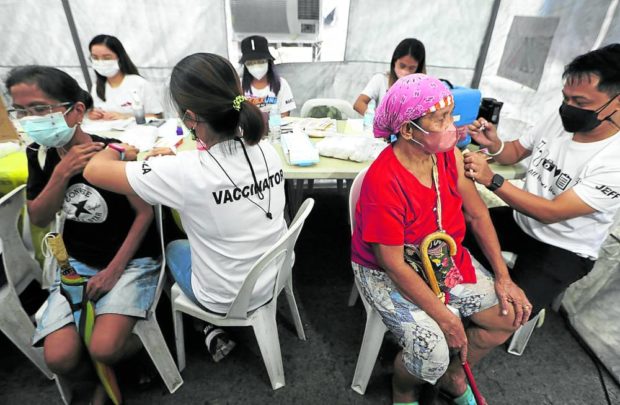Metro’ Manila’s COVID growth rate up by 25%–OCTA

ADDED PROTECTION Market vendors receive their booster shots during the Department of Health’s COVID-19 vaccination drive at Commonwealth Market in Quezon City on Aug. 30.
—NIÑO JESUS ORBETA
The Department of Health (DOH) reported on Monday an additional 17,891 COVID-19 cases from Sept. 19 to 25, or an average of 2,556 infections daily, up by 22 percent compared to the 14,707 cases from Sept. 12 to 18.
The daily case average also increased from last week’s 2,101, the DOH said, as independent pandemic monitor Octa Research Group observed that the number of new cases recorded in Metro Manila on Sunday exceeded the peak registered in August.
In a post on Twitter, Octa Research fellow Guido David said the National Capital Region (NCR) logged 1,600 new COVID-19 cases on Sept. 25, higher than last month’s peak of 1,502 new cases reported on Aug. 7.
“The one-week growth rate in the NCR increased to 25 percent as of Sept. 25, almost double the one-week growth rate of 13 percent on Sept. 18,” David said.
He also noted an increase in the region’s reproduction and positivity rates.
Article continues after this advertisementReproduction rate refers to the average number of people who can potentially be infected by the coronavirus, while positivity rate is the percentage of tests conducted that came out positive for COVID-19.
Article continues after this advertisementThe World Health Organization’s (WHO) benchmark positivity rate of below 5 percent, sustained for two weeks, indicates that virus transmission is under control.
According to Octa, the reproduction number went up from 1.21 on Sept. 15, to 1.30 on Sept. 22.
The seven-day positivity rate in Metro Manila also increased to 18.5 percent on Sept. 24, from 15.7 percent on Sept. 17. “This has already exceeded the positivity rate of 17.5 percent on Aug. 5,” David said.
Despite this, the region’s health-care utilization for COVID-19 remained “low” at 36 percent, according to him. “Cases are expected to increase further, but we expect hospital bed occupancy to remain at low levels,” he added.
Latest deaths
The DOH, meanwhile, reported two new severe and critical cases that accounted for 0.01 percent of the new cases reported for the week.
A total of 242 new COVID-19 fatalities were verified during the past week, 34 of which occurred this month. The rest happened between April 2021 and January 2022, but were reported only in the past week.
The latest fatalities pushed the death toll to 62,790, while the country’s total caseload as of Sept. 25 was 3,938,203, according to the DOH COVID-19 bulletin.
To date, there are 35,399 active cases, and 3,840,014 who recovered from the respiratory illness.
As of Sept. 25, there were 790 severe and critical admissions, the DOH said, adding that this was 11 percent of the total COVID-19 admissions.
On the other hand, 5,851 out of 21,078 or 27.8 percent of non-intensive care unit (ICU) beds were occupied while 576 out of 2,514 or 22.9 percent of ICU beds were in use.
The DOH weekly case bulletin also included the government’s vaccination accomplishment with over 73 million Filipinos or 93.49 percent of the target population now fully vaccinated against COVID-19.
Of this number, 119,850 were fully vaccinated from Sept. 19 to 25.
The DOH also said that over 19.2 million individuals had received their booster shots, with 328,452 boosted during the same period.
Further surge possible
Dr. Rontgene Solante, a member of the government vaccine expert panel, meanwhile, said that antibody-evasive Omicron subvariants could lead to more COVID-19 cases amid low booster vaccination coverage, noncompliance with minimum public health standards and increasing social mobility.
Speaking at the televised Laging Handa public briefing, Solante said that aside from the BA.5 Omicron subvariant that was now the dominant COVID-19 strain in the country, there were other equally transmissible variants such as BA2.75 that had been detected in 48 countries, and its mutation BA2.75.2.
The Philippine Genome Center’s sequencing results made public earlier this month showed that of the sampled 436 Omicron cases, 425 were caused by the BA.5 subvariant, 10 by BA.4 and only one by BA.2.
“We are also experiencing patients [coming] from households, the same family. And in fact, most of them are only COVID antigen-positive. What Octa sees are only the RT-PCR positive. So, it could be more than the 2,000 that we would expect and we know why cases are rising: there is high mobility among the people, many are relaxing health protocol compliance, they are not wearing face masks anymore and are attending several gatherings,” Solante said.